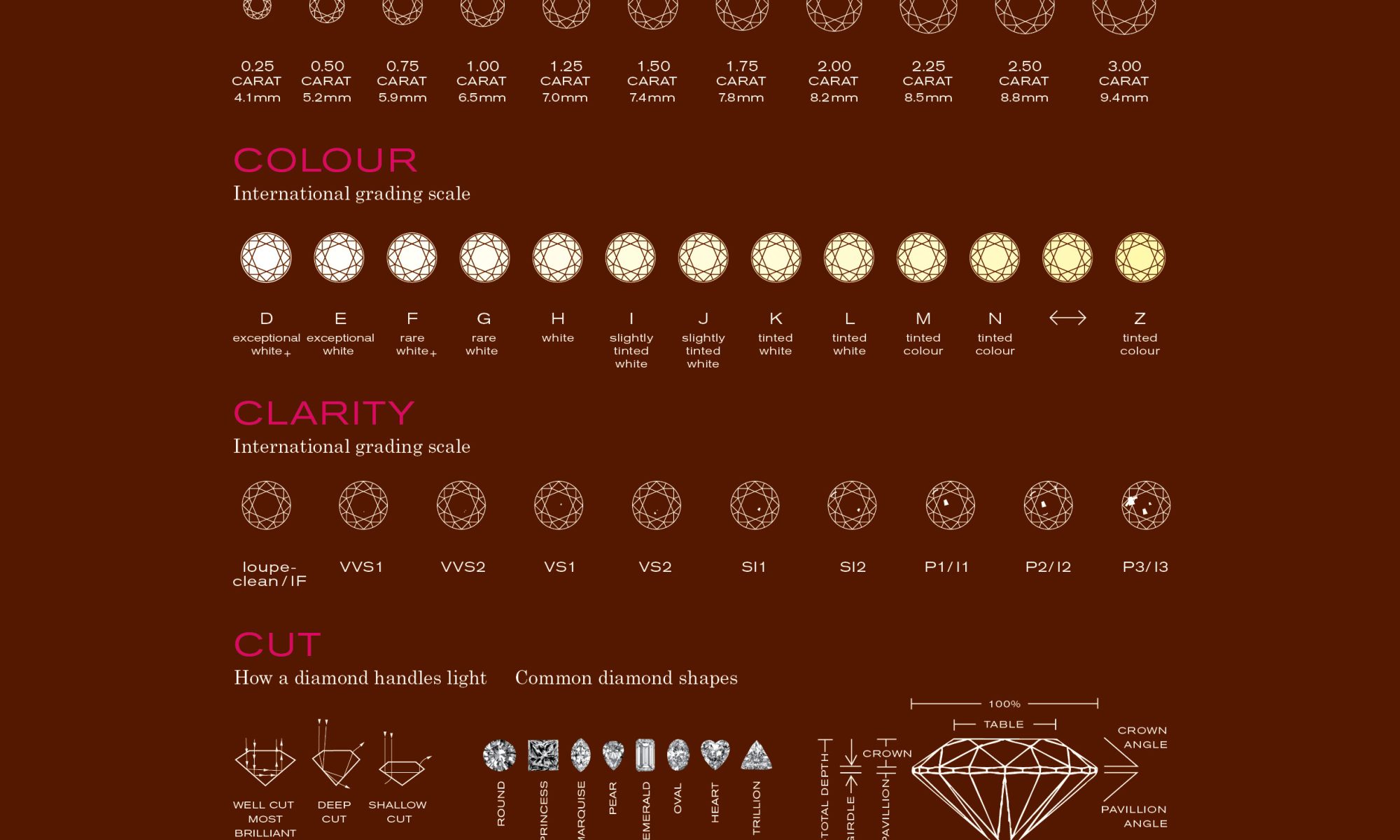The Four C’s of Diamonds: Cut, Colour, Clarity, and Carat Weight
The Four C’s are the standard criteria used to evaluate and grade diamonds. Understanding these factors helps you choose the best diamond for your needs, whether for an engagement ring, jewellery, or investment. Here’s a breakdown of each C:
1. Cut: The Most Important “C”
What It Is:
The cut refers to how well the diamond has been shaped and faceted, impacting its brilliance (sparkle) and overall appearance. Unlike the diamond’s other characteristics, the cut is man-made, so it can be influenced by the diamond’s cutter.
Why It’s Important:
A well-cut diamond will reflect light beautifully, making it sparkle and shine. The precision of the cut can enhance or detract from a diamond’s natural beauty. Even the highest-quality diamonds with poor cuts can appear dull.
Cut Grades:
Excellent: Maximises brilliance with precise symmetry and proportions.
Very Good: Nearly as brilliant as excellent cuts, with minor differences.
Good: Fairly good brilliance, but may have some visible flaws in symmetry or proportions.
Fair: Less brilliance due to poor proportions or symmetry.
Poor: The diamond lacks brilliance and light return, often looking dull.
Key Factors of Cut:
Proportions: The diamond’s height, width, and depth must be in proper balance.
Symmetry: The alignment of the facets and angles.
Polish: The smoothness of the surface, affecting how well the diamond reflects light.
2. Colour: The Absence of Colour
What It Is:
The colour of a diamond refers to how colourless or yellow the diamond appears. The less colour, the more valuable the diamond, as colourless diamonds are rarer and more highly prized.
Why It’s Important:
The more colourless a diamond is, the more light it can reflect, enhancing its sparkle. Yellow or brown tints can reduce the diamond’s brilliance.
Colour Grades: The GIA grades diamonds on a scale from D (colourless) to Z (light yellow or brown).
D-F: Colourless – These diamonds are highly prized for their lack of any visible colour.
G-J: Near Colourless – These diamonds show very slight colour, but the tint is usually undetectable to the naked eye.
K-M: Faint Yellow – These diamonds may show a slight yellow or brownish tint.
N-Z: Light Yellow or Brown – These diamonds have noticeable colour, often making them more affordable.
3. Clarity: The Presence of Inclusions and Blemishes
What It Is:
Clarity refers to the number, size, and location of inclusions (internal flaws) and blemishes (external imperfections) in a diamond. The fewer inclusions or blemishes, the higher the clarity grade and the more valuable the diamond.
Why It’s Important:
While inclusions can sometimes affect a diamond’s brilliance, many diamonds have small imperfections that are invisible to the naked eye. It is essential to consider how visible these imperfections are when evaluating clarity.
Clarity Grades:
Flawless (FL): No internal or external imperfections visible under 10x magnification.
Internally Flawless (IF): No internal flaws, though surface blemishes may be present.
Very, Very Slightly Included (VVS1, VVS2): Inclusions are very difficult to detect even under 10x magnification.
Very Slightly Included (VS1, VS2): Inclusions are minor and visible only under magnification.
Slightly Included (SI1, SI2): Inclusions are noticeable under magnification, but not to the naked eye.
Included (I1, I2, I3): Inclusions are visible to the naked eye and can affect the diamond’s clarity and brilliance.
4. Carat Weight: The Size of the Diamond
What It Is:
Carat weight measures the size of the diamond. One carat equals 200 milligrams, or 0.2 grams. While carat weight directly influences a diamond’s size, it does not necessarily correlate with the diamond’s quality—a smaller diamond can still be of higher quality if it has better cut, colour, and clarity.
Why It’s Important:
The size of the diamond is often one of the most noticeable factors when buying a diamond. Larger diamonds, especially those with high quality, are more expensive and rarer. However, it’s essential to balance size with the other C’s to ensure a diamond’s overall beauty and value.
Carat Weight and Price:
Larger diamonds are more expensive, but prices increase exponentially for diamonds with higher carat weight. Two diamonds of the same weight can differ greatly in price depending on their cut, colour, and clarity.
How the Four C’s Work Together
The Four C’s are all interrelated. For example, a diamond with excellent cut and high clarity might appear more brilliant than a larger diamond with lower clarity or colour grade.
Balance is key: While carat weight can give the appearance of size, the cut and clarity have a significant impact on the diamond’s overall sparkle. For diamonds with strong fluorescence, colour and clarity may be slightly affected.
Choosing the Right Diamond
When choosing a diamond, you need to consider the Four C’s carefully based on your preferences and budget:
If sparkle and brilliance are most important to you, cut is the most significant factor.
If you want a diamond that appears as colourless as possible, focus on the colour grade.
If you’re looking for a diamond with few imperfections, you’ll need to pay attention to the clarity.
For a larger stone, focus on the carat weight, but balance it with the other C’s for the best overall result.
